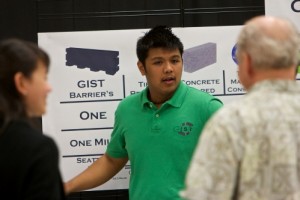Challenges drive environmental innovation
Why are “challenges” so crucial in driving innovation? We asked Connie Bourassa-Shaw, the director of UW’s Center for Innovation and Entrepreneurship about this, specifically in relation to the Center’s annual Environmental Innovation Challenge. Here’s what she had to say:
We launched the Environmental Innovation Challenge in 2009 because we believe that “challenges” drive innovation, and we were looking to engage smart, passionate students in the quest to produce real, market-conscious solutions to environmental problems. My story at the time was the Solar Car Challenge, which has been going on for the last decade or so. Most people know it. But the point is that we’re still not driving solar cars. That’s what I didn’t want to see. I wanted to see market results with the EIC.
So we narrowed it down to this: Tell me what the environmental problem is, tell me about your solution, show me that it works, tell me about the market opportunity, and demonstrate the potential for impact. Now, what we’re asking students to do is hard. Designing and building a prototype is hard. Getting it to work is even harder. And we’re not interested in the $5,000 solution to the $500 problem. It’s got to be appropriate technology, especially when you’re looking at technologies targeted for third-world countries.
The Challenge is run by CIE (which is in the Foster School of Business), in partnership with the College of Engineering and the College of the Environment. We want cross-disciplinary teams–from undergrads to PhD students. We start the process with a fall quarter class–the Environmental Innovation Practicum. Those students walk through the process of thinking about and planning for the Challenge, which happens late March or early April. We get $25,000 from the College of Engineering to provide small grants ($500 to $5,000, but generally under $2,000) to teams that need prototype funding. We give all the money away.
This year (2012) GIST won the $10,000 grand prize. Barrels of Hope and Urban Harvest won prizes as well–and both went on to our annual Business Plan Competition, which follows the Challenge. In fact, about half of the EIC teams go on to do the BPC.
What happens is really interesting–students get caught up in the excitement of thinking about making this a real company. Many are very serious.
The EIC is full of great stories, and the “challenge” process itself is the key.

